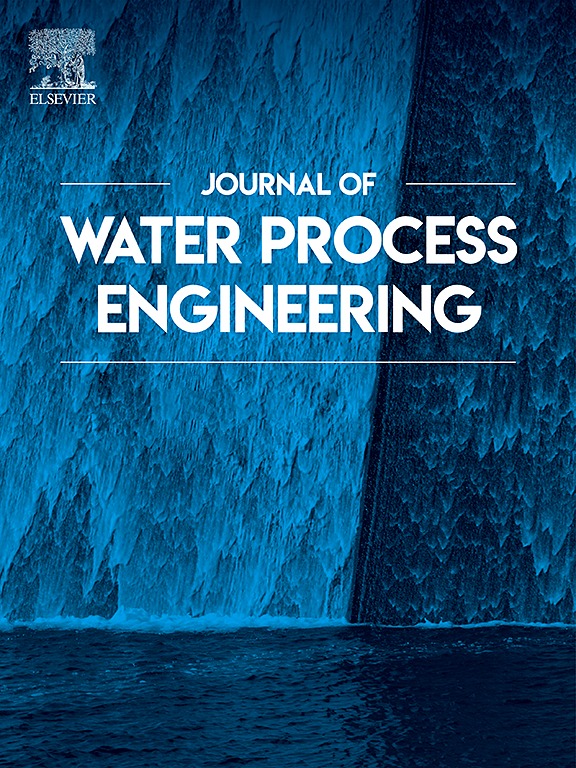添加Fe3+促进好氧颗粒污泥形成及稳定性处理低强度废水
IF 6.7
2区 工程技术
Q1 ENGINEERING, CHEMICAL
引用次数: 0
摘要
好氧颗粒污泥(AGS)因其对污染物降解效率高、占地少等特点而受到广泛关注。然而,AGS在处理低强度废水中的应用还面临着AGS形成周期长、运行稳定性差等问题。在本研究中,Fe3+被用于增强AGS的形成和稳定性。AGS在序批式反应器(SBR)中培养,进水化学需氧量(COD)设定为150 mg/L。结果表明:在进水中添加Fe3+后,9 d内可快速形成AGS,对COD、氨氮(NH4+-N)、总氮(TN)和总磷(TP)的去除率分别为81%、96%、35%和33%;而对照组(不含Fe3+)无AGS,污染物去除率较低。AGS的细胞外蛋白含量约为150 mg/g,高于对照组。第47天,AGS的粒径达到669 μm。结果表明,Fe3+可以刺激色氨酸和酪氨酸蛋白、酰胺I带、β-胞外多糖的产生。这些物质被认为对AGS的形成和稳定性有很大的贡献。此外,Fe3+可以刺激zogloea的生长,增加胞外聚合物质(EPS)的分泌,刺激假黄单胞菌的生长,提高AGS的稳定性。该研究为AGS在低强度废水处理中的应用提供了策略。本文章由计算机程序翻译,如有差异,请以英文原文为准。

Fe3+ addition for enhancing the formation and stability of aerobic granular sludge to treat low-strength wastewater
Aerobic granular sludge (AGS) has attracted great attention because of its characteristics of high pollutant degradation efficiency, less land occupation. However, the application of AGS in treating low-strength wastewater is still facing some problems, such as long period requirement for AGS formation and poor operation stability. In this study, Fe3+ was employed to enhance the AGS formation and stability. The AGS was cultured in a sequencing batch reactor (SBR) and the influent chemical oxygen demand (COD) was set at 150 mg/L. The results showed that AGS was formed rapidly within 9 days when Fe3+ was added to the influent, and the removal efficiency of COD, ammonia nitrogen (NH4+-N), total nitrogen (TN) and total phosphorus (TP) were 81 %, 96 %, 35 % and 33 %, respectively. However, no AGS was observed in the control group (without Fe3+) and the pollutant removal was low. The AGS's extracellular protein content was about 150 mg/g mixed liquid suspended solid concentration (MLSS) which was higher than that in the control group. On day 47, the particle size of AGS reached 669 μm. It was found that Fe3+ could stimulate the production of tryptophan and tyrosine proteins, Amide I band, β-exopolysaccharides. These substances are considered having a great contribution to the formation and stability of AGS. In addition, Fe3+ could stimulate the growth of Zoogloea to enhance the secretion of extracellular polymeric substance (EPS) and stimulate the growth of Pseudoxanthomonas to improve the stability of AGS. The study has provided a strategy for AGS application in low-strength wastewater treatment.
求助全文
通过发布文献求助,成功后即可免费获取论文全文。
去求助
来源期刊

Journal of water process engineering
Biochemistry, Genetics and Molecular Biology-Biotechnology
CiteScore
10.70
自引率
8.60%
发文量
846
审稿时长
24 days
期刊介绍:
The Journal of Water Process Engineering aims to publish refereed, high-quality research papers with significant novelty and impact in all areas of the engineering of water and wastewater processing . Papers on advanced and novel treatment processes and technologies are particularly welcome. The Journal considers papers in areas such as nanotechnology and biotechnology applications in water, novel oxidation and separation processes, membrane processes (except those for desalination) , catalytic processes for the removal of water contaminants, sustainable processes, water reuse and recycling, water use and wastewater minimization, integrated/hybrid technology, process modeling of water treatment and novel treatment processes. Submissions on the subject of adsorbents, including standard measurements of adsorption kinetics and equilibrium will only be considered if there is a genuine case for novelty and contribution, for example highly novel, sustainable adsorbents and their use: papers on activated carbon-type materials derived from natural matter, or surfactant-modified clays and related minerals, would not fulfil this criterion. The Journal particularly welcomes contributions involving environmentally, economically and socially sustainable technology for water treatment, including those which are energy-efficient, with minimal or no chemical consumption, and capable of water recycling and reuse that minimizes the direct disposal of wastewater to the aquatic environment. Papers that describe novel ideas for solving issues related to water quality and availability are also welcome, as are those that show the transfer of techniques from other disciplines. The Journal will consider papers dealing with processes for various water matrices including drinking water (except desalination), domestic, urban and industrial wastewaters, in addition to their residues. It is expected that the journal will be of particular relevance to chemical and process engineers working in the field. The Journal welcomes Full Text papers, Short Communications, State-of-the-Art Reviews and Letters to Editors and Case Studies
 求助内容:
求助内容: 应助结果提醒方式:
应助结果提醒方式:


